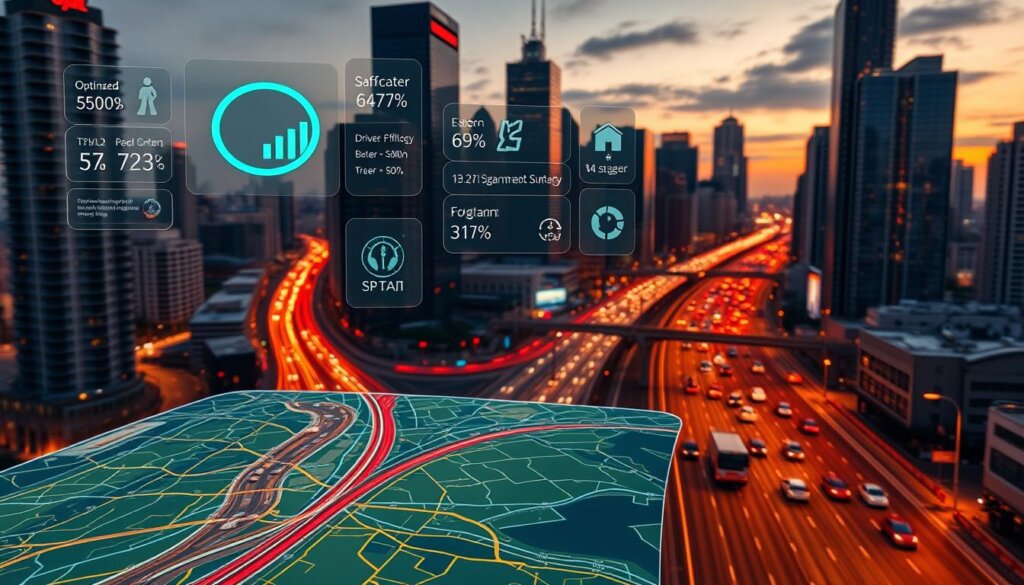Imagine a local bakery delivering fresh bread across Chicago. For years, their drivers zigzagged through traffic, wasting hours and fuel. Then something changed. By reorganizing delivery routes, they cut driving time by 30% – saving money and reducing exhaust fumes in their community. This quiet revolution is happening nationwide.
The transportation sector creates 15% of global emissions, with last-mile delivery being the most fuel-intensive phase. Traditional methods often send half-empty trucks through congested streets. But new technologies are flipping the script.
One logistics platform helped businesses save 77 million miles – enough to circle Earth 3,000 times. Their secret? Smart algorithms that bundle orders and plot efficient paths. This isn’t just about being eco-friendly – it’s practical business sense. Companies using these methods report lower costs alongside smaller environmental impacts.

Key Takeaways
- Route optimization cuts unnecessary miles, saving fuel and reducing emissions
- Last-mile delivery accounts for disproportionate environmental costs
- Advanced algorithms can bundle orders and streamline fleet movements
- Efficient routing benefits both company budgets and community air quality
- Real-world implementations show millions of miles saved annually
- Urban areas see reduced traffic congestion through smarter delivery planning
Understanding Sustainability in Dispatch: A Case Study Overview
Picture a clothing retailer navigating Manhattan’s gridlock for same-day deliveries. Their vans once idled in traffic, spewing exhaust while drivers searched for parking. Route optimization transformed their operations – cutting delivery times by 25% and slashing emissions. This real-world example shows how smarter logistics create environmental and business wins.
Background on Environmental Challenges in Last-Mile Delivery
Final delivery stages chew through resources. The EPA reports transportation contributes 15% of global greenhouse gas emissions, with last-mile logistics being the hungriest part of the supply chain. Why? Tight delivery windows, unpredictable traffic, and scattered drop-offs force vehicles into inefficient routes.
Traditional methods struggle here. Half-empty trucks circle neighborhoods. Drivers make multiple attempts when customers aren’t home. These inefficiencies pile up – more fuel burned, more emissions released, higher costs for businesses.
Case Study Insights and Objectives
A Midwest grocery chain’s experiment reveals solutions. By using dispatch software to group orders and predict traffic, they reduced miles driven by 18% in six months. Their secret? Algorithms that balance delivery deadlines with route efficiency.
This approach tackles multiple issues at once. Fewer vehicles on roads mean cleaner air. Lower fuel bills improve profit margins. Customers get reliable deliveries without environmental guilt. It’s proof that smart logistics benefit everyone – companies, communities, and the climate.
Innovative Route Optimization Strategies for a Greener Future
Consider a Phoenix pharmacy chain delivering medications across metro areas. Their drivers previously made separate trips for prescriptions and over-the-counter products. Now, smart route optimization lets them combine both in single journeys – cutting daily miles by 22% while serving more customers.

Multi-Stop Deliveries and Order Bundling Techniques
Modern algorithms analyze delivery windows and street layouts simultaneously. They group orders heading to the same neighborhood, even if placed hours apart. This intelligent bundling means fewer vehicles idling at red lights – one van replaces three on busy routes.
Dynamic systems adjust paths in real-time. A Miami florist using this tech reroutes drivers around accidents automatically. Packages arrive faster, engines run cleaner, and businesses save 18% on fuel costs annually. It’s like having a traffic cop and environmental scientist in your dashboard.
These strategies work because they balance multiple factors. Vehicle capacity, delivery deadlines, and even weather patterns get calculated together. The result? Drivers complete 35% more stops per shift while burning less gas. Customers still get porch-drop precision without extra emissions.
Real-world results prove the impact. A Midwest hardware supplier reduced their fleet size by 40% after implementing multi-stop routing. Their drivers now earn bonuses for efficient routes – proving eco-friendly practices boost both morale and margins.
Reducing Fuel Consumption and Emissions through Advanced Technology
A Dallas electronics distributor faced spiraling fuel costs as their vans crisscrossed the metroplex daily. Their solution? A cloud-based routing platform that slashed idle time and optimized every turn. This shift demonstrates how modern technology tackles twin challenges: cutting operational costs and environmental impact.

Algorithmic Routing and Data-Driven Efficiency
Smart systems analyze traffic patterns, vehicle specs, and delivery windows in milliseconds. Unlike human planners, these algorithms juggle 50+ variables without breaking stride. One logistics provider reduced fuel consumption by 10% fleet-wide – equivalent to removing 300 cars from roads annually.
The magic lies in scalability. Whether coordinating 50 trucks or 5,000, the technology maintains peak efficiency. It even accounts for unexpected hurdles like road closures, rerouting drivers before they hit snags.
Impact on Fuel Consumption and Vehicle Emissions
Real-time visibility transforms operations. Dispatchers track vehicles like chess pieces, while drivers submit delivery proof via mobile apps. This data loop identifies wasteful patterns – like repeated left turns across busy lanes – that quietly drain fuel.
Every optimized route compounds benefits. A Midwest fleet cut emissions by 18% in six months simply by eliminating backtracking. As algorithms learn from each day’s runs, they prevent tomorrow’s wasted miles today.
Leadership and Technological Advancements Driving Sustainability in Dispatch
Think about a courier service in Atlanta handling urgent medical supplies. Their leadership team transformed operations by baking environmental responsibility into every decision. CEO Andrew Leone puts it plainly: “Our tools should make delivery effortless while protecting communities we serve.” This philosophy drives Dispatch’s tech-first approach to greener logistics.
CEO Andrew Leone’s Vision and Strategic Direction
Leone’s strategy treats eco-friendly practices as business fundamentals, not checkboxes. “Efficiency and environmental care fuel each other,” he notes. Under his guidance, Dispatch developed solutions that help businesses slash delivery miles while maintaining service quality. The Courier Partners Network exemplifies this – connecting companies with local drivers to minimize cross-town hauls.
Product Enhancements and Technological Innovations in 2024
This year’s upgrades focus on smarter resource use. The improved Driver Onboarding System cuts training time by 40%, helping independent contractors adopt sustainable habits faster. SAP ERP Integration lets enterprise clients sync delivery data with inventory systems, reducing unnecessary trips.
CTO Jason Kirton’s team embeds environmental metrics directly into routing algorithms. New AI tools predict package volumes to right-size vehicles automatically. For businesses in b2b last-mile delivery, these innovations mean fewer emissions without sacrificing speed.
Conclusion
A Denver furniture store recently redesigned its delivery strategy using smart routing tools. Within months, they reduced neighborhood traffic by 19% while serving 15% more customers. This story reflects a broader shift – businesses now recognize that eco-conscious logistics drive both operational gains and community benefits.
The global last-mile sector’s growth to $318 billion by 2032 demands smarter approaches. Platforms combining real-time traffic data with order bundling prove that reducing miles directly lowers emissions. When 54,000+ companies collectively save 77 million miles, it shows scalable solutions exist for cleaner deliveries.
Success hinges on integrated systems. Route optimization, driver-friendly tools, and customer communication must work together. Independent contractors using these platforms complete more stops per day while burning less fuel – a win for earnings and air quality.
Leadership teams prioritizing this balance see lasting results. As consumers reward brands with lighter carbon footprints, the companies embracing efficient last-mile logistics will lead tomorrow’s markets. The path forward is clear: every optimized route strengthens both business viability and environmental responsibility.
See how FieldAx can transform your Field Operations.
Try it today! Book Demo
You are one click away from your customized FieldAx Demo!
FAQ
How does route optimization help reduce environmental impact in delivery logistics?
Advanced routing tools analyze traffic patterns, weather, and order density to create efficient paths. This minimizes unnecessary miles, lowers fuel use, and cuts greenhouse gas emissions. Companies like Elite EXTRA use algorithms to bundle orders, reducing trips and idle time.
What role do independent contractor drivers play in sustainable last-mile logistics?
Contractors using optimized routes complete more deliveries per trip, lowering per-stop emissions. Platforms with real-time tracking ensure drivers follow eco-friendly paths, while incentives for efficient practices promote greener habits across fleets.
Can B2B last-mile delivery solutions truly lower a company’s carbon footprint?
Yes. Tools like dynamic routing and order consolidation reduce vehicle wear, fuel consumption, and CO2 output. For example, combining multi-stop deliveries with electric vehicle (EV) fleets can slash emissions by up to 30% compared to traditional methods.
How do CEO Andrew Leone’s strategies align with sustainability goals in dispatch tech?
Andrew Leone emphasizes integrating AI-driven routing and real-time data analytics to boost efficiency. His 2024 roadmap includes EV integration and enhanced load-balancing algorithms, aiming to cut fleet emissions while maintaining delivery speed.
What everyday steps can businesses take to make deliveries more eco-friendly?
Adopt route optimization software, train drivers on fuel-efficient driving, and bundle orders. Partnering with platforms offering emission-tracking dashboards also helps companies monitor progress and adjust strategies for greener outcomes.
How do 2024 product enhancements address fuel consumption challenges?
New features like predictive traffic modeling and EV-compatible routing reduce reliance on fossil fuels. Real-time adjustments for weather or road closures further prevent wasted miles, ensuring fleets operate at peak efficiency with minimal environmental impact.
Author Bio
Co-Founder & CMO at Merfantz Technologies Pvt Ltd | Marketing Manager for FieldAx Field Service Software | Salesforce All-Star Ranger and Community Contributor | Salesforce Content Creation for Knowledge Sharing






